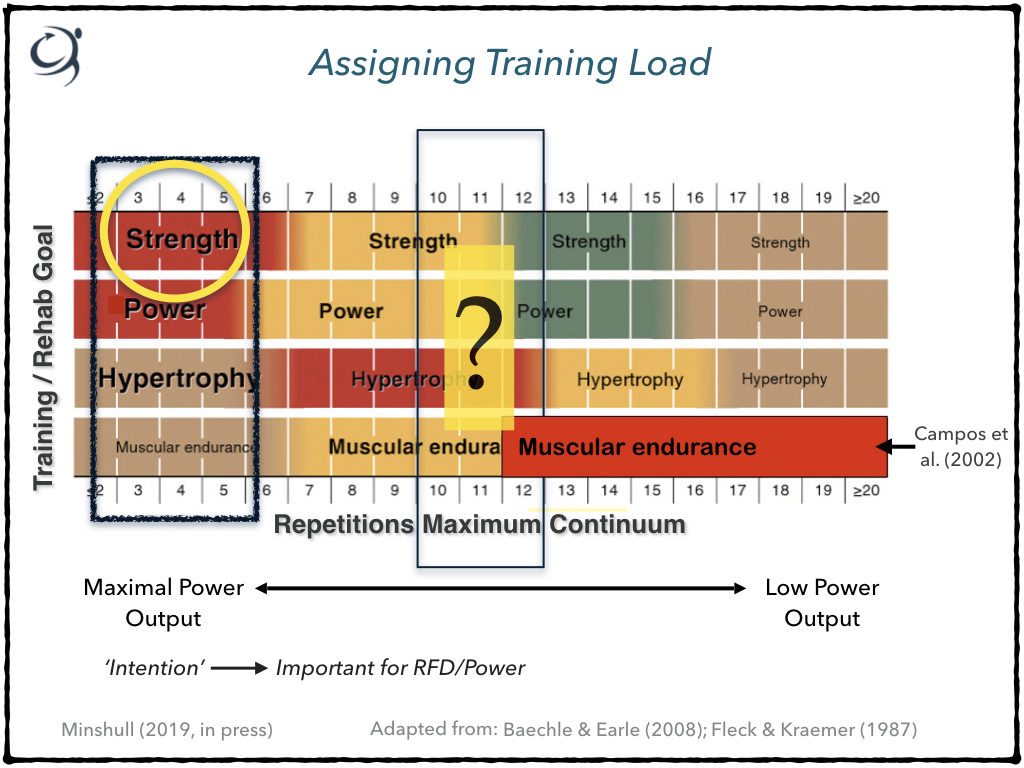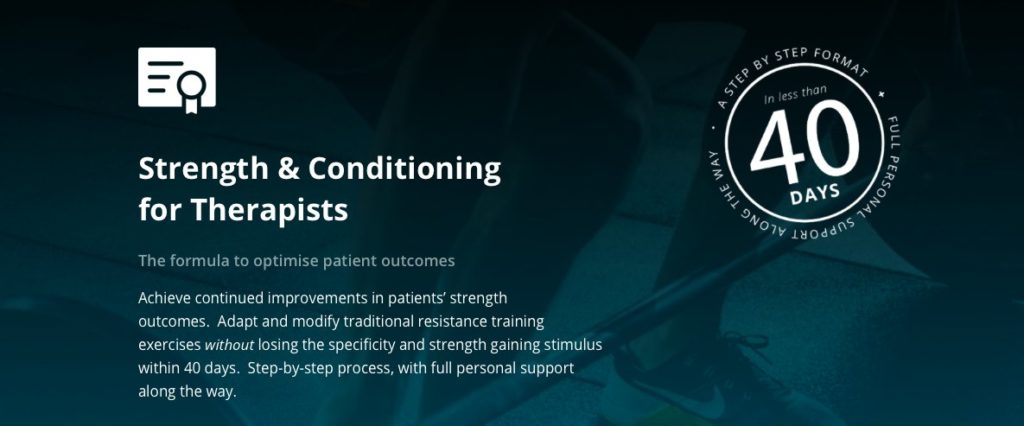Hi everyone. Welcome to post 38 of Strength and Conditioning for Therapists. Last week we started to address the topic of hypertrophy; establishing the basics and its potential application within rehabilitation. Today we’re going to focus on building muscle hypertrophy and how to do this in rehabilitation programmes.
Hypertrophy In Rehabilitation
So, a reminder of the application. It’s not often we hear of patients walking into clinic asking to look buff 😉 and you’re not typically charged with supersizing muscle for body building competitions. Patients often present with a visually-identifiable, unilateral reduction in limb girth on one side compared to the other. In MSK situations this is often a result of injury, surgery, disuse – or all 3!
As we mentioned last week, the loss of muscle cross-sectional area (CSA) can happen quickly, potentially 4% following just 5 days of immobilisation in health young men. In older populations and those with generally lower muscle mass this might be visually more difficult to discern, but not to say that it doesn’t happen!
So in clinical and rehabilitation settings, a common application of a muscle hypertrophy programme might be to try ‘correct’ the loss or rebuild the muscle CSA to that similar of the opposite non-injured side.
Specificity of Resistance Training
As with any resistance training programme, whether that be with patients, athletes or the general public, it’s a bloomin’ good idea to know what you’re (or they’re) doing it for!
Specificity is key here and it will enable your patents to achieve the specific outcomes with greater efficiency (assuming they adhere!). The principle of specificity enables you to design an exercise programme to hone the conditioning stimuli to optimise the specific adaptation you want to achieve. In this particular post we’re talking about developing muscle hypertrophy, indeed optimising muscle hypertrophy, not muscle strength.
Any resistance training programme is made up of a few standard parameters, such as:
- intensity of exercise
- reps and sets
- frequency
Manipulation of these variables will change the specificity of the programme and of course the outcomes. So, what should we be looking at to maximise hypertrophy gains…?
Optimising Muscle Hypertrophy
What do you reckon? How would you structure a programme to promote muscle CSA gains?
Intensity of Exercise: Load
Now there’s some suggestion that low load (<60% 1RM [repetitions maximum]) and high load (>60% 1RM) resistance training (RT) promote similar hypertrophy gains. Well specifically there was no significant difference between groups in this meta analysis (Schoenfeld et al. 2017). This is interesting, and as the authors also suggest, training with low loads to failure requires a lot more time commitment and volume of work compared to higher load training, thus, high-load training may be more efficient approach. In patient populations where you’re trying to achieve buy-in the shorter time commitment might be useful.
Download my free 14-page guide to Strength & Conditioning
Indeed, this approach of ‘high loads’ is also supported by the strength-endurance continuum, see below. This is a really useful resource (available in the S&C guide above) and works on the repetition-maximum (RM) principle. A 10RM represents a load that can only be lifted (with correct form) 10 times; the exercise is performed to failure. I adapted this figure to explain specificity of strength training, but it works here too. The larger the size of text, the larger the training stimulus. You can see that I’ve highlighted 3-5RM as the optimal RM range for strength development and also 10-12 RM to to question its utility.

Look a the 3rd row and the size of text for hypertrophy. You can see that higher intensity (3-5RM) and thus heavier loads are potentially more effective than lower intensity (10-12RM) and lighter loads at maximising hypertrophy. This might well be true, but, it’s not just that simple. VOLUME is important. Also, more recent depictions of this continuum have edged the optimal hypertrophy stimulus along a bit – to 7- 11 RM
Can we get a little more specific to help exercise prescription..?
There are multiple studies that use the 8-12RM to elicit muscle hypertrophy. It’s difficult to say definitively whether 8-12RM is better than say 3-5 RM, given equivalent volume of because of the paucity of studies that have investigated directly this. Indeed the great systematic review by Schoenfeld et al. (2017) comparing high and low load on strength and hypertrophy outcomes used groupings of <60% 1RM and >60% 1RM, respectively. Given that 12RM equates to roughly 70% 1RM, you can see the problem here… are we really looking at high loads..?
So, let’s make it easier and simplify the question of prescription. Let’s go with 8-12 RM as the selected repetition range for muscle hypertrophy programmes.
It important to note the RM bit here! It’s generally accepted, no matter what overload you use, that it is necessary to work to failure, i.e. the person is unable to perform any more reps, with proper form.
Reps, Sets & Volume
So, we’re going with 8-12 reps, now we need to know how many sets … within the session, across the week, how many weeks ?? Again, you can go to the literature and find multiple papers that investigate the ‘how many sets?’ question. Before you delve in, however, it’s important to know what you’re looking at and understand first the overload, or intensity of exercise used, or else you could end up comparing apples with oranges.
For example 3 sets might not be better than 5 sets in one study using an intensity of 95% 1RM, but it may be in studies using an exercise intensity of 75% 1RM.
In general, more sets are better than fewer, but that’s not very helpful. So here’s here’s a table I constructed from data from another study by Schoenfeld et al. (2019), and which nicely illustrates the specificity of exercise prescription.

It’s important to note here that the population used was (of course!) university aged males, and who had on average 4-years worth of RT experience. I’ve just taken the lower limb data here to illustrate; it’s easy to spot that there were no significant differences between the strength gains of 1, 3 or 5 Sets per week group in pre- to post training scores. That is to say performing a greater number of sets per week did not enhance strength gains (bear in mind here the specificity of the programme wasn’t designed to optimise strength). However, there was a statistically significantly effect for muscle CSA; performing a greater volume of training resulted in a larger hypertrophic response (5% vs 8% vs 14% increases in CSA). Look at the total number of sets performed above over the 4-week period.
Frequency of Training
This is about accruing the necessary volume and taking into account the RT status of your patient. If they’re habituated trainers then hypertrophic changes are likely to be observed sooner than in those who are novices. See how in the above study differences were observed following just 4-weeks of training in habituated trainers?
Why? Well I’m sure you remember that the initial adaptation to a RT programme are neural… cited to be something like 6-weeks or so, though it can be less. This means that any early changes in muscle performance are likely explained by changes in neural drive, decreased inhibition, improved synchrony of firing of motor units etc. and NOT due to morphological changes.
Accordingly, if you’re prescribing a muscle hypertrophy programme to an untrained individual, it may be several more weeks before you start to notice a difference.
A great study by Kubo et al. (2010) illustrates this nicely. I’ve mentioned this study before; they measured the time course of adaptation and then loss of aspects of muscle function and CSA in untrained university ages males (shock!). It took 8-weeks of training (4x/wk, 70%MVC x 10) to elicit significant gains in group mean strength, but 12 weeks of training to see any significant change in muscle CSA.
Muscle Hypertrophy – The Optimal Dose?
So we haven’t even spoken about number of sessions per week yet, and thus the number of reps accrued in total and for different populations. Or the inter-set rest. Phew – this requires a little more work, but let’s save that for another post.
From what we’ve covered so far, can we get to a decent prescription or best dose of RT exercise to elicit optimal changes in muscle hypertrophy in patients?
- Intensity 8-12RM (though we realise this could be higher)
- Work to failure
- 5 sets per muscle group (40-60 reps)
- 1-2 times per week (total weekly volume 40 – 120 reps*)
- 4 – 12 weeks (dependent on training status)
PLUS:
- Inter-set rest of up to 3 minutes*
- Include single-limb exercise (esp. if imbalance/single-limb atrophy)
*Based on studies not covered here (yet!)
Summary
Bit of jam-packed and lengthy post here, but I think we’ve managed to get to a useful end point and a muscle hypertrophy prescription that you can start to use with your patients. Yes, there are other things that we need to looking into, but I think you’ won’t go far wrong if you follow these guidelines. Remember, specificity is key!
NEXT WEEK – Where should hypertrophy come in the order of rehabilitation outcomes and how to fuel adaptation?
ONLINE COURSE

Want to know more? Check out our international online programme. There are just 2 enrolments per year (March & September), so make sure you’re on the wait list.
If you’ve downloaded the free 14-page S&C Guide for therapists, then you’re on the mailing list and you’ll be first to hear about the Online S&C course (whoop). Make sure you check your junk mail for our e-mails!
If you haven’t downloaded this guide, what are you waiting for? Over 5000 people are using it right now. Just click the link above and you’re good to go!
References
- Schoenfeld et al. (2017). Strength Cond Res 31(12): 3508–3523
- Kubo et al. (2010).J Strength Cond Res.24(2):322-31
- Schoenfeld et al. (2019). Med. Sci. Sports Exerc., 51(1):94–103


